Phytophthora
While the name Phytophthora might not mean much to you, these organisms are a menace to agriculture and forests alike.
The name is derived from Greek and tells you what you need to know about them: plant destroyers.
Once thought to be fungi, these water molds are now considered a separate type of organism. However, they are as aggressive and destructive as any fungus.
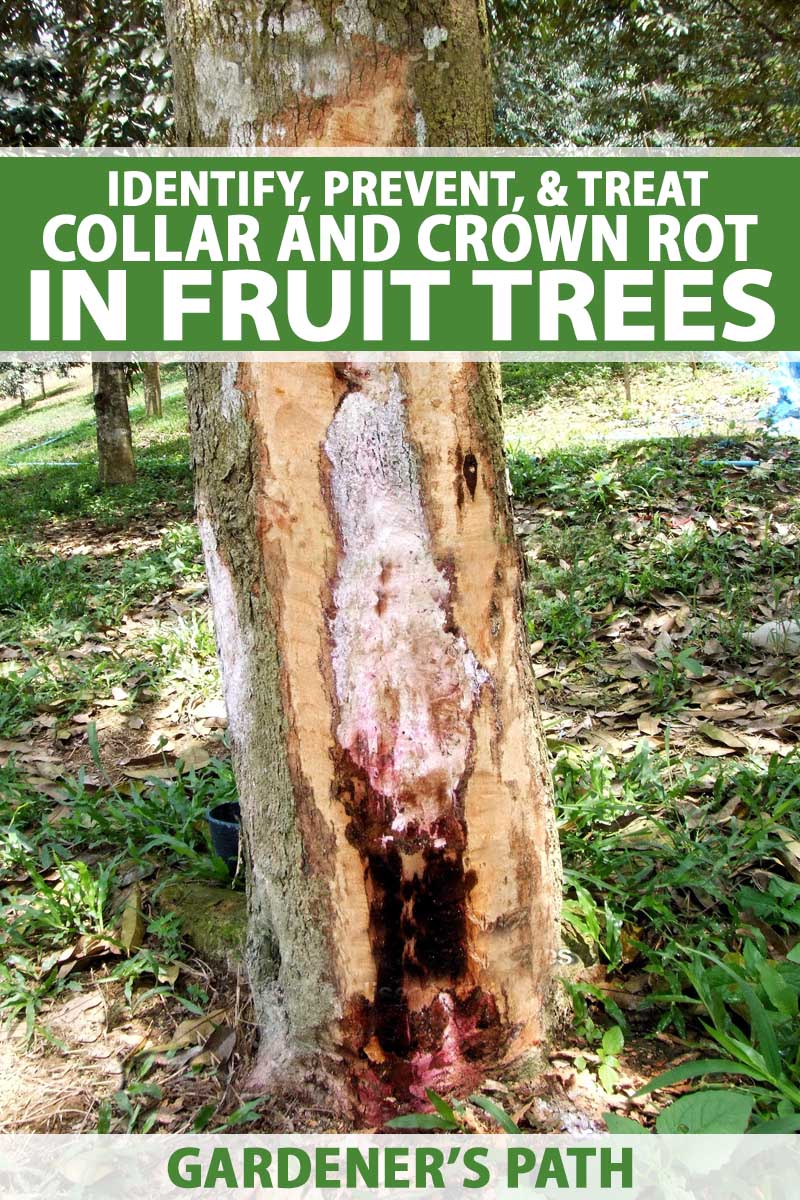
We link to vendors to help you find relevant products. If you buy from one of our links, we may earn a commission.
More than 100 species of Phytophthora cause a complex of diseases on hundreds of kinds of plants. Several different species can infect temperate fruit trees such apple and crabapple, pear, peach, apricot, plum, and cherry and also tropical fruit trees such as oranges, limes, and lemons.
Difficult to diagnose, these organisms can kill the fine roots (root rot), damage the roots right below the soil surface (crown rot), and rot the tree above the union (collar rot).
Read on to learn how to distinguish Phytophthora infections from other fruit tree pathogens and steps you can take to prevent these debilitating diseases.
What You Will Learn
Collar Rot Symptoms
You may not even realize your trees are infected until you discover that the scion has been totally girdled, and your trees are on death’s doorstep.
Look at the lower part of the scion, and you may be able to see a depressed canker that can be purple, grey, or dark brown. A dead giveaway can be a gummy exudate under the dead bark.

Another symptom can be early ripening of the fruit, which may be small and highly colored.
Armillaria root rot (the honey mushroom) is another devastating disease that can cause similar symptoms. Armillaria infections start at the roots and move upwards, while Phytophthora collar rot starts at the crown and spreads down towards the roots.
Another way to distinguish these two infections is to look at the decayed tissue. The honey mushroom produces fan-shaped mycelia.
However, it may take a lab test to prove that the rot is due to Phytophthora. This is worth having done, since the future of your trees may depend upon this knowledge!
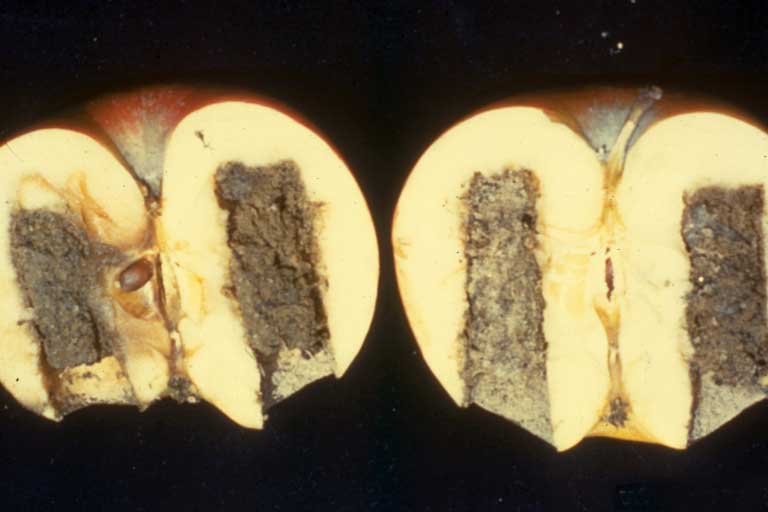
This disease can be intermittent, too. It may not be a problem for several years. However, with a prolonged period of cool, wet weather in the spring before blooming – boom, your trees can suddenly be infected.
Crown Rot Symptoms
Diagnosing crown rot can be a judgment call, since the trees show very similar symptoms if the crown or the fine roots have been subject to rot.

Your tree may have an obvious decline that could be due to many factors, including fire blight and winter injury.
Remove the soil from around the trunk and look at the crown. Peel back the bark from the trunk. If it is infected with Phytophthora, the bark will be orange or brown instead of green.
Phytophthora Can Infest Soils for Years
Once this pathogen is in your soil, it will stay there. Phytophthora produces two types of spores that can lurk in the soil for years. Both oospores and chlamydospores have thick walls and can resist weather like drought or freezing.
Unfortunately, these spores are very resistant to treatment with chemicals. As soon as spring arrives, the oospores can germinate in crevices in the bark.
Another problem with these organisms is that they can spend the winter in trunk cankers. The mycelia can overwinter there. As soon as the temperatures start warming up, they are poised and ready to infect the trunk or root collar.
And it gets worse! When conditions get favorable, a few oospores can turn into large numbers of spores that can swim in films of water. These spores, called zoospores, can infect large numbers of trees in a short period of time.
How to Prevent Crown and Collar Rot
While there are some steps you can take if your tree isn’t too badly damaged, your best bet is to try and avoid the problem. Here are some tips on ways to do this:
1. Grow Resistant Cultivars and Rootstocks
While resistant rootstocks can help prevent collar and crown rot, no one rootstock is resistant to all the species of Phytophthora that can infect various temperate fruit trees.
Knowing what kind of Phytophthora is in your soil can help to determine which rootstock to choose. You should consult with experts in your area to determine which rootstocks and cultivars are likely to resist infection.
2. Minimize Wet Soil
Try not to plant in soil that drains poorly, has a lot of clay, and is damp and low. Planting on a slope will provide the most drainage.
Channel water away from the trunk – do not allow a saucer to form in the soil around it. And make sure that you don’t flood your trees if you irrigate them.
3. Improve Your Soil Structure
You can limit the chances of your soil being excessively wet if it has a lot of organic matter and has low compaction. Work on building organic matter over time by incorporating compost, grass clippings, and other materials.
4. Use Biopesticides
Believe it or not, the soil is a vicious place. Microbes aggressively compete with each other by producing chemicals (like antibiotics) or even directly feeding on each other.
You can harness this competition to your advantage by inoculating the soil with beneficial microbes. A number of soil microbes can act as biopesticides, including the fungus Trichoderma.
You can buy special microbes to inoculate the soil. And you can also increase their natural populations by adding a lot of organic matter to your soil.
Some recent research suggests that you can apply these types of organisms as a dip before planting or on newly planted trees using the dripline.
5. Support Your Trees
We don’t mean emotional support. Young trees that rock back and forth in the wind can develop an open area around the base of the trunk that invites infection.
Make sure to use a trellis or stake, so your tree is properly supported.
6. Minimize Winter Injury
Trees that have been damaged in the winter are vulnerable to Phytophthora infection, so take steps to minimize winter injury.
The way to do this is to avoid new growth in the mid or late fall. For example, avoid fertilizing in the late summer or early fall.
7. Plant Your Tree Shallow
If you plant your fruit tree more deeply than it was in the nursery, it can cause two problems. One is that it will be more susceptible to collar rot. The other is that you can lose the dwarfing when the cultivar strikes roots.
What to Do if Your Tree Comes Down with a Phytophthora Rot
If your tree has a severe infection, you should remove it and declare that area a loss for fruit prodction. However, if the infection is in its early stages, there are some steps you can try.
Expose the entire cankered area of the tree and let it dry. You can do this by cutting away all the diseased tissue and leaving the trunk area open. Then put fresh soil back in the late fall.
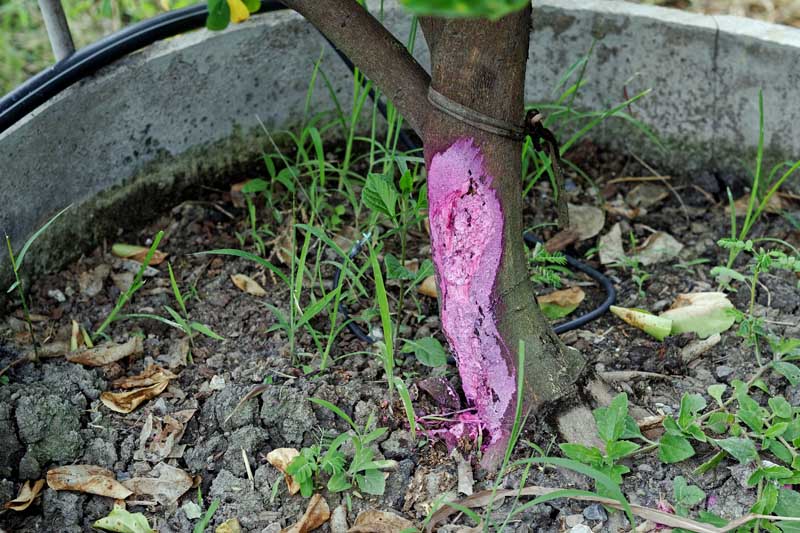
You can also try grafting a one-year-old resistant cultivar whip into the trunk. Be sure and put it much higher than the canker. This will not work if 25-50% or more of the trunk is infected.
If the infection isn’t too severe, fungicides may be another option. Since water molds aren’t fungi, your choice of fungicides will be restricted.
You can treat the root zone and other infected areas with metalaxyl or mefenoxam. Be sure to treat the entire root zone or area of infection. Or you can spray the trunk and root zone with phosphorous acid or potassium salts or fosetyl. Do not mix these fungicides with a copper spray.
Phytophthora is a Menace to Fruit Production
With hundreds of species of Phytophthora infesting soils all over the world, it can be difficult to avoid these insidious organisms.
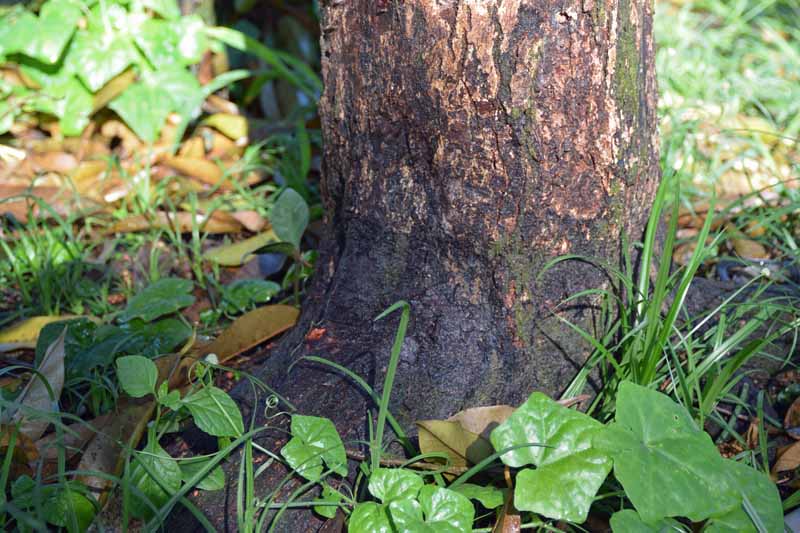
You can take steps to prevent infection by not planting your trees in wet soil and keeping the area around them from flooding.
However, if you have severe Phytophthora rots in the collar, crown, or roots of your trees, the disease will persist in the soil. You may have to forego planting apples and crabapples, pears, peaches, plums, apricots, cherries, or citrus fruits in that location.
And be sure to check out some of these guides for other tips and tricks in preventing or treating various fruit tree diseases or physiological conditions:
- What’s the Difference Between Tree Burr Knots (Burl) and Crown Galls?
- How to Identify, Prevent, and Treat Gummosis on Fruit Trees
- How to Manage Root Rot in Fruit, Nut, and Landscape Trees and Shrubs
© Ask the Experts, LLC. ALL RIGHTS RESERVED. See our TOS for more details. Uncredited photo: Shutterstock.
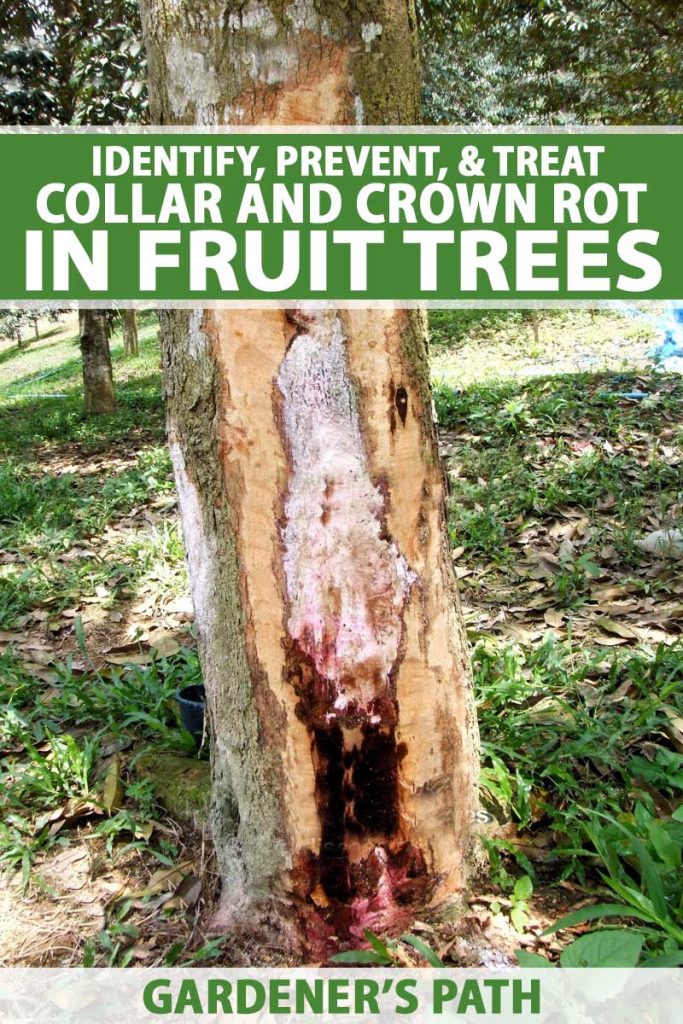
Please help me to identify the disease in my apple trees. This disease degenerates my many of the Apple trees (native and traditional Plants) mostly after winter and I come to know about it in Spring only. This also happens for a selected part in my orchid and the land is hilly with limited water retaining capacity. Please help.
While I can’t be positive, it does look like your trees have crown rot. You can try a fungicide called metalaxyl that has some specificity for water molds (the type of organism that I think is attacking your trees). You paint it on the section of the trees that are showing symptoms. Good luck, and I hope it helps!
Does my cherry tree have Phytophthora?
Hi Manuella,
I am so sorry about your cherry tree. I don’t think the problem is Phytophthora. Those symptoms are pretty classic for the fungus Armillaria, which is very aggressive and incredibly difficult to control. I think you will have to remove your tree. Here is an article on Armillaria that describes the symptoms and what to do if you have an infected tree in more detail: https://gardenerspath.com/how-to/disease-and-pests/armillaria-root-rot-apple-trees/. I wish the news was better.
Please help me identify the cause of the rot in my beautiful apple tree. We woke to find a lower branch had split from the tree and was lying half on the ground. The spot where it was removed appears to have rot, as does the branch itself. There is a circle of grayish rot about 3″ in diameter in the center of the branch.
Thank you in advance if you can point me in a direction.
Hi Pam, it looks like your tree has a wood-rotting fungus. There are numerous fungi that can cause this, including: Chondrostereum purpureum, Polyporus hirsutus, Schizophyllum commune, Trametes versicolor. Regardless of which you have, there isn’t a whole lot you can do besides provide your tree with some support. First, try to chip away as much of the rot as you can using a chisel. Then, if the rot extends deep into the tree, you might want to provide some support using guy lines attached to deep stakes in the ground. Finally, trim back a few heavy, large branches on the… Read more »
My advanced fruiting Babaco has a grainy sort of rot creeping up the trunk on one side. The weather is cold and damp. Tree is in a large terra-cotta pot. What can I use to stop this “fungus” ???
Thank you.
Can you please help me to identify the disease in my almond trees? I couldn’t find any solution to heal them. Thank you!
Here is the picture of it
Hi Che, I’ve found your picture, sorry it didn’t upload properly the first time!
Hello Helga,
I have a number of white pine trees, Douglas fir and spruce trees in an area. I’ve attached a couple of pictures. I hope you can see that the pine needles are all brown, and apparently the tree is dead. Would you be able to help me identify what I’m dealing with here in order to treat and protect the trees remaining.
Thank you
Mark
Hi Mark, is it just the pine that is being impacted at this point? The gummy oozing and persistent dead needles are indicative of pine blister rust. We talk more about this disease in our guide to pine trees. It only impacts pines, so if your other evergreens are showing symptoms, then we need to go back to the drawing board. As for the white fungal growth, that looks like the kind of growth that forms when a tree is planted too deep or has mulch or an overgrowth of grass up against it. If you remove the dirt, grass,… Read more »
Hello Kristine,
Yes, it is only the pine being impacted. I will remove some of the grass and dirt around the base and see if that helps.
Thank you for the information.
Mark
Sounds like it might be pine blister rust, then. Hopefully the white growth will resolve. Let us know if we can help!